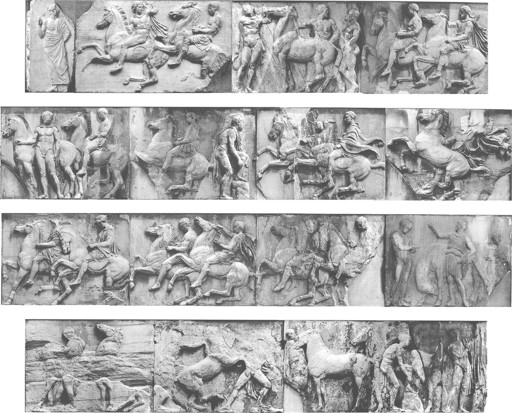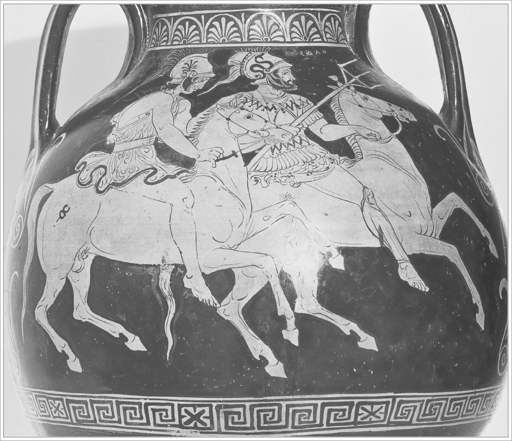The Parthenon Enigma (39 page)
Read The Parthenon Enigma Online
Authors: Joan Breton Connelly

The west frieze is generally viewed as representing preparations for the Panathenaic procession (below). Frisking horses are held, mounted, and put through their paces by younger and older men. Iconographic parallels have been drawn between these figures and those shown on a series of Athenian red-figured cups.
177
The vases show young horsemen in a variety of costumes, including the wide-brimmed traveler’s hats, “coonskin” caps, and Thracian hats with flaps, the very same variety evident on the Parthenon frieze. The event depicted on the Attic cups has been identified as the
dokimasia
, an annual tryout of men and horses held by the Athenian cavalry, as described by
Aristotle.
178
A central element of the
dokimasia
was the testing of Athenian youths in their eighteenth year for acceptance into the military as ephebes. This is the age at which young men would enter their names upon deme registers as members of their tribes.
179
They swore their
Ephebic Oath upon
the arms they’d just received in the
sanctuary of Aglauros on the east slope of the Acropolis (insert
this page
, bottom).
180
This
oath, as discussed in
chapter 3
, was regarded as a relic of the heroic age, a rite of passage reaching back to the earliest days of Athens. In the images of the young riders on the Parthenon frieze, Athenians would likely have recognized the origins of their contemporary
ephebate
.
181
Indeed, the lofty status of the Athenian knights finds its roots in the
cavalry of King Erechtheus, the young noblemen who won the city’s first decisive victory in the battle against Eumolpos. We must remember that in the early sixth century, when
Solon reconfigured the citizenry in a first blueprint for what would become Athenian democracy, the
hippeis
class, made up of those who had enough money to maintain a horse and thus join the cavalry, ranked second only to the wealthiest of Athenian landowners.

West frieze, Parthenon, showing horse riders and preparation for the procession. (illustration credit
ill.79
)
THIS NEW MYTHOLOGICAL READING
of the Parthenon’s sculptural program allows it to be understood as a coherent whole and as comprehending the vast sweep of time embedded in Athenian consciousness. The east pediment celebrates the origins of Athena, while the east
metopes show the boundary event in which she first distinguished herself so valiantly: the
Gigantomachy. The west pediment celebrates the origins of Athens in the contest of Athena and
Poseidon, manifesting for all to see the genealogies of the royal houses of Athens and Eleusis. It emphasizes the descent of the Athenian tribes from Athena through Kekrops and Erechtheus and that of the Eleusinian clans from Poseidon through Eumolpos and
Keleos. The “
boundary catastrophe” of the
deluge is intimated by Poseidon’s striking the earth with his trident, furious at his defeat. The west metopes, in turn, show the later, heroic age in which
Theseus battles the Amazons, while the south metopes memorialize his decisive role in the Centauromachy. The north metopes manifest that greatest boundary event of all, the
Trojan War, which brought a decisive end to the Bronze Age, the final moment dividing mythical from historical time. The articulation and perpetuation of
genealogical narrative can thus be seen as a primary function of sacred architectural sculpture in general and of the Parthenon in particular.
182
Our mythological understanding of the frieze fits comfortably into this genealogical program, with the great carved band narrating the last Athenian hurrah of the heroic age: the war between Erechtheus and
Eumolpos. By portraying the struggles of successive generations against the forces of chaos and barbarism, the Parthenon’s sculptural program repeats a pattern already witnessed on the
Archaic Acropolis and discussed in
chapter 2
. The limestone pediments of the Hekatompedon and the small poros buildings (
oikemata
) present, respectively,
Zeus killing Typhon and Zeus’s son, Herakles, killing Typhon’s daughter, the
Lernaean Hydra. In the very same way, the conflict between
Athena and
Poseidon on the Parthenon’s west pediment is carried on by their children,
Erechtheus and Eumolpos, as depicted on the Parthenon frieze. And so have the Athenians, generation by generation, ensured a future for their city. As it was, so shall it ever be: the Parthenon’s full sculptural program is also, of course, a not-so-subtle metaphor for the Athenian triumph over the
Persians in 479
B.C.
183
It is the duty of all Athenians to save the city from exotic, barbaric outsiders, to preserve an Athens by and for the autochthonous Athenians: this is the central message of this supernal temple, where metaphysical understanding and civic solidarity are wedded for all to see. That the frieze shows the royal family itself personally paying the ultimate price to save Athens is of the highest significance, and not merely for offering a heroic contrast to the ways of the Persian royals, who survived the great defeat at Salamis. That the very founding family of Athens, from whom all are descended, could not put itself above the
common good speaks to a radical egalitarianism, not in circumstances, but in responsibility, the very antithesis of the barbarian sentiment that society exists for the exaltation of its most exalted members. All may not be equal in Athens, but all are equal in relation to this sacred trust, which comes of being bound to the same earth and to one another by birth. And this trust in one another is what permitted the delicate plant of democracy to take root.
ANGELOS CHANIOTIS
, professor of ancient history and classics at the
Institute for Advanced Study in Princeton, has observed that “from
Plato to
Aelius Aristides, the praise of Athens was always based on a standard constellation of Athenian victories over the barbarians: the victory of Theseus over the Amazons, of Erechtheus over Eumolpos, and the
Persian Wars.” He asks, “Can the victory over Eumolpos, so prominent in Athenian collective
memory, be the only one absent from the
iconography of the Parthenon?”
184
Indeed, the Athenian victory over Eumolpos is not only present on the Parthenon; it is spectacularly celebrated in the largest, most lavish, and most aesthetically compelling length of sculpture ever carved by human hands.

Poseidon and Eumolpos ride into battle. Lucanian pelike from Herakleia, near Policoro, Italy. (illustration credit
ill.80
)
When
Pausanias visited the Acropolis, he saw a big bronze statue group of Erechtheus fighting Eumolpos set up right in front of the Parthenon. He tells us that this was the most important work ever created by the master sculptor Myron of Eleutherai, that acclaimed portrayer of the so-called
Myronic moment of tension before the high action, as exemplified in his statue of the
Diskobolos
.
185
Since Myron was active in the middle of the fifth century, we can imagine his bronze Erechtheus in battle set just below the sculptured frieze on which his great victory was glorified.
By the fourth century
B.C.
, the war of Erechtheus and Eumolpos was so well known that it was painted on a vase produced in the Western Greek colony of Lucania in southern Italy. Vibrant images on this wine jar from Herakleia, near Policoro, portray the antagonists charging into battle.
186
On one side of the vase we see Poseidon, riding with trident held high and accompanied by an armed warrior who is, surely, his son Eumolpos (above). The father-son duo charge into battle astride
horses, creatures with which Poseidon always had a very special connection, having been known since the
Iliad
as the “tamer” of horses and, thanks to his creative coupling with mares, even as the “father” of some equines. In time, Poseidon acquires the epithet
Poseidon Hippios.
187
On the other side of the vase we see Athena, spear in one hand and shield in the other, as she is driven into battle on a chariot (below). Just as the horse is special to Poseidon, so the chariot is special to Athena as the vehicle introduced to Athens by her own “son,” Erechtheus/Erichthonios. The charioteer, however—and most astonishingly—is a maiden. The girl leans forward, holding her reins high and brandishing a whip, as she urges the yoked horses toward the battlefield. This maiden is likely to be none other than Erechtheus’s brave daughter, shown here as Athena’s comrade in the war against Eumolpos. Portraying Athena as a kind of
apobates
rider to the girl’s charioteer, the artist makes explicit the goddess’s intimate connection to the maiden called Parthenos, the girl who gave her life to save Athens.
The fact that the battle of Erechtheus and Eumolpos is not attested in surviving literature prior to Euripides’s
Erechtheus
has led some scholars to question whether it can be represented on the Parthenon frieze. Since Euripides wrote “a decade after the frieze was finished,” one skeptic argues, “the play cannot be the source of the sculpture.”
188
Of course it can’t, and no one has claimed that it is. As we have seen, the popularity of a particular myth, like that of its variants, can ebb and flow over time. It is even possible that the arrow of inspiration was shot the other way, with Euripides getting his idea from what he saw on the Parthenon frieze. What if those wordlessly eloquent images moved him to bring to the stage the very story most prominently narrated on his city’s newest and most wondrous temple? And what if the Erechtheus myth, reenergized in the wake of the
Persian Wars, was expanded to include a major victory over an exotic enemy, evoking that most recent, and greatest, of all Athenian triumphs? One can understand how the story of Erechtheus, elevated to a new prominence within Athenian consciousness, reached a peak in popularity at this time, celebrated in architectural sculpture, ritual practice, and, yes, drama. As
Perikles and the Athenians renewed their Acropolis, they embraced a reinvigorated hero, a fresh face for a fresh start.

Athena and daughter of Erechtheus ride into battle. Lucanian pelike from Herakleia, near Policoro, Italy. (illustration credit
ill.81
)
A false assumption that text precedes image has long bedeviled our understanding of visual culture. It is motivated, in part, by the mostly documentary and illustrative role that images play in our contemporary world, capturing moments in time as supplement to the main work of literary accounts. The field of classical archaeology has been particularly beset by this bias, going back to the days of
Heinrich Schliemann and earlier, when written texts were the primary guides and the archaeologist’s job was to search for material evidence to support what the texts say, just as Schliemann used the
Iliad
to discover the Troy and Mycenae of Homer. In a field shaped for centuries by philological inquiry, visual culture has invariably suffered, its distinctive grammar and stories neglected.
